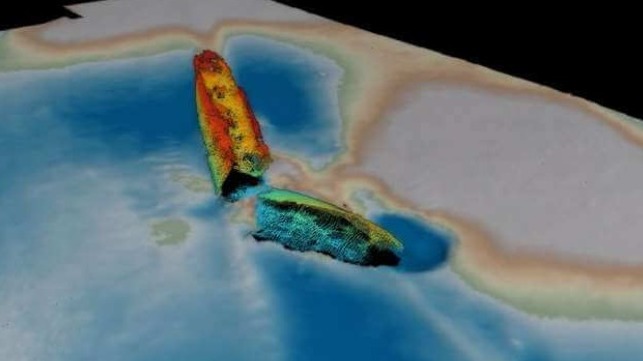Sonar Survey Uncovers Fate of the Steamship That Tried to Warn Titanic

Researchers at Bangor University have found and identified the wreck of the SS Mesaba, the steamship that sent an iceberg warning to the ill-fated RMS Titanic.
At 1950 hours on April 14, 1912 - the night of Titanic's sinking - Mesaba's wireless operator sent a Morse code message to the passenger liner to warn that Mesaba's crew had spotted "much heavy pack ice and great number large icebergs." The message was one of four ice warnings which reached Titanic's radio room that day but were never relayed to the bridge; all went unheeded, and the vessel had her fatal encounter with an iceberg 20 minutes before midnight.
Mesaba met a similar fate on September 1, 1918. She was under way in the Irish Sea in a convoy to Philadelphia when she was targeted by a German U-boat, U118. She was torpedoed and sunk at a position off County Wexford, with the loss of 20 men; 78 others were rescued by a Royal Navy gunboat.
Mesaba passed from the world's knowledge for more than 100 years, but multibeam sonar scanning has brought her location to light once more. The SS Mesaba was one among 273 shipwrecks in a 7,500 square mile survey area which were recently scanned with sidebeam sonar and then checked against the U.K. Hydrographic Office's database - without ever diving the wreck sites for a visual check. Researchers with Bangor University correctly identified Mesaba with this technique, fixing a previous team's mistaken conclusion about the site's identity.
Details of Mesaba and all the wrecks in the study have been published in a new book by Dr. Innes McCartney of Bangor University.
"Previously we would be able to dive to a few sites a year to visually identify wrecks. The [research vessel] Prince Madog's unique sonar capabilities has enabled us to develop a relatively low-cost means of examining the wrecks. We can connect this back to the historical information without costly physical interaction with each site," said Dr. McCartney. "It is a 'game-changer' for marine archaeology."
